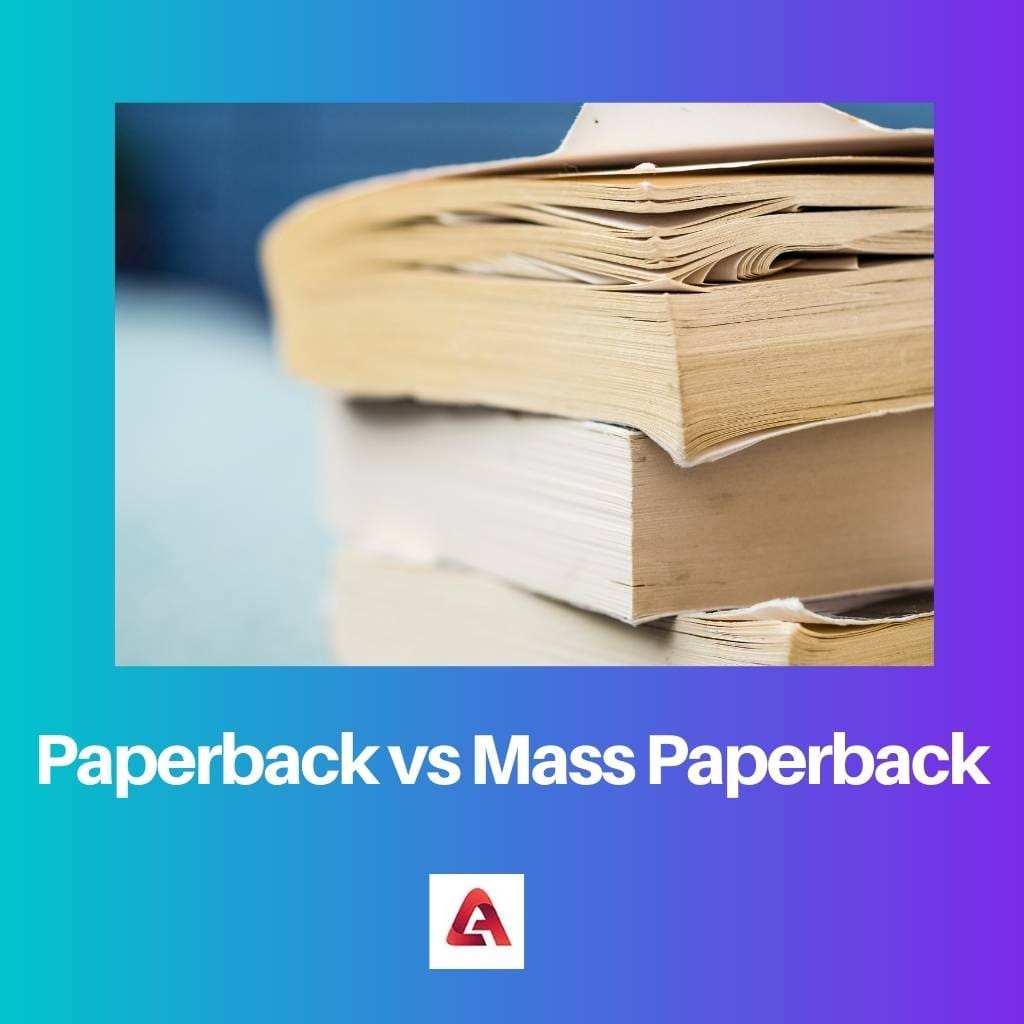The one who loves to read books, novels, magazines, etc., is a book collector or an emerging writer who knows the difference between the physical formats of the books in which they are published.
The different physical format of the book comes in different shapes and sizes, the quality of the paper, the difference in their binding, and the hardcover.
Key Takeaways
- Paperback refers to a book with a paper cover that is less durable than hardcover books.
- The mass paperback is a small, portable version of paperback books that are inexpensive and sold in large quantities.
- Paperback books are larger and more expensive than mass paperbacks but are also more durable and of better quality.
Paperback vs Mass Paperback
Paperbacks are a type of book printed on high-quality paper, resulting in a higher price. It is larger in size than mass-market paperbacks. Mass-market paperbacks are books printed on smaller, lower-quality paper and are more affordable for consumers.

Paperback editions are books that are also known as softcover or softback. The books that are published under the paperback edition are held by the glue does not like (hardcover in which the inner pages are bound by stitches and staples).
The paperback editions of the book are published by the publishers in a low-cost format.
Mass Paperback are books that are printed on very low-grade quality paper. Books with cheap quality paper get deteriorate with time.
The books that are not sold in the market can be stripped out. That is, the cover of the book is stripped, and sometimes the first few pages of the book may also be stripped out, and the rest of the book is recycled.
Comparison Table
| Parameters of Comparison | Paperback | Mass Paperback |
|---|---|---|
| Size of Page | Large | Smaller around 2 inches |
| Price/Cost | High | Much lower |
| Quality | The quality of the pages used in the paperback edition is very good. | The quality of the cover page and the inner pages are very poor compared to paperback edition books. |
| Bar code Reading | The bar code used by paperback editions is EAN code. | The bar code used by the mass paperback editions is UPC. |
| Font Size | The font size is large and fewer words are fitted on a page. | The font size is small and thus more words are fitted on the page. |
| Spacing | More spacing between the words | Less spacing between the words |
| Availability | They can be found in bookstores or libraries as they are not easily accessible to the readers. | They can be found in retail stores, gift shops, or convenience stores as they are easily accessible to the readers. |
What is Paperback?
Paperback editions are books that are also known to be softcover or softback. Also, they can be referred to as the ‘trade paperback’’. The books that are published under the paperback editions are the copy of the same title book that are already printed in the hardcover versions.
Or they can be individually printed to lower the cost of the books. Despite being the cheaper version of the hardcover, the size, pages, quality of the paper, etc., are quite similar to that.
The size of the paperback edition book is smaller than that of hardcover books or similar to them, that is about (5.5’’ × 8.5’’ or 6’’ × 9’’). The quality of the pages used for publishing the paperback edition is very good.
The font size used is also largely because of which there is more spacing between the words, and contains a greater number of pages. The pages in the books are intact by the glue, and they can be easily found by readers in bookstores and libraries.

What is Mass Paperback?
Mass Paperback edition books are the ones that are the smaller version of the paperback editions. In simple terms, the same title books are published on paper that is of very low quality, and the page of the book gets discolored or deteriorates with time.
These books are quite small in size and can be kept handy in small bags or in a pocket. The approximate size of the mass paperback edition books is about 4’’ × 7’’.
The mass paperback edition books are very cheaper because of the low quality of being used. The books come with small font sizes and thus creating less spacing between the words.
Also, because of the smaller font size, a single page accommodates a large number of words, ultimately resulting in a smaller number of pages.
The books can be stripped and can also be recycled. These books are easily available to readers in convenience stores, retail shops, gift shops, etc.

Main Differences Between Paperback and Mass Paperback
- The paperback edition books are quite large in size, while comparatively, on the other hand, the mass paperback edition books are smaller in size, approximately about 2 inches small.
- The paperback edition books are quite high in price while comparatively, on the other hand, the mass paperback edition books are much lower in price.
- The paperback edition books use very high-quality paper for the covers and the inlet pages, while comparatively, on the other hand, the mass paperback edition books use very cheap quality paper for their inside pages.
- The paperback edition books use a different bar code which is the EAN code, whereas comparatively, on the other hand, the mass paperback edition books use another bar code, which is the UPC code.
- The paperback edition books use a very large font size which is why fewer words are present on the page, whereas comparatively, on the other hand, the mass paperback edition uses a very small size font which is why there are more words present on the page.
- The paperback edition of the books uses large size font because of which the spacing between the words is very large, whereas comparatively, on the other hand, the mass paperback edition of the books uses a small size font because of which the spacing between the words is very small.
- Paperback edition books are easily available for the readers in the book stores or in the library, whereas comparatively, on the other hand, the mass paperback edition books are easily available in the drugstore, retail shops, gift shops, etc.

References
- https://muse.jhu.edu/article/453551/summary
- https://www.cambridge.org/core/journals/journal-of-modern-african-studies/article/abs/global-journalism-a-survey-of-the-worlds-mass-media-edited-by-merrilljohn-cnew-york-longman-1983-pp-vi-374-2500-1895-paperback-comparative-mass-media-systems-edited-by-martinjohn-and-chaudharyanju-grovernew-york-longman-1983-pp-viii-356-1250/8CAB4C8D403C88D4055CD8902F9010B8
- https://crl.acrl.org/index.php/crl/article/view/15983
- https://scripts.iucr.org/cgi-bin/paper?pf0052

Incredible analysis! The breakdown of the differences between paperback and mass paperback editions was incredibly informative. I’ve gained a whole new perspective on these publishing formats.
This article delved into the specifics of paperback and mass paperback editions in a way that was both engaging and enlightening. I now have a much clearer understanding of these different formats.
I couldn’t agree more, Tharrison. The clarity and depth of information were truly impressive.
This article provided a comprehensive overview of paperback and mass paperback editions. I learned a lot, particularly about the paper quality and durability of these different formats.
I share your sentiment, Caroline39. The comparison in quality and price was particularly illuminating.
I found the discussion about the font size and spacing in paperback and mass paperback editions to be very insightful. It’s incredible how these seemingly small details can impact the overall reading experience.
I completely agree, Kirsten. The attention to detail in this article was exceptional.
Thanks for the detailed breakdown! As someone who loves collecting books, it’s fascinating to understand the differences between the paperback and mass paperback editions.
Absolutely, Gwood. I particularly appreciated the comparison table that outlined the different parameters between the two formats.
As an avid reader, I found this article to be incredibly informative. The detailed explanations of the paperback and mass paperback editions were fascinating and added depth to my understanding of these formats.
I share your sentiment, Vharris. The article was a treasure trove of information for book enthusiasts.
The detailed comparison table in the article was incredibly helpful in understanding the nuanced differences between paperback and mass paperback editions. It’s remarkable how each parameter contributes to the overall format of the book.
I completely agree. The granularity of the comparison table was impressive in breaking down the distinctions between the formats.
Absolutely, Russell Rosie. The comparison table was a standout feature of the article.
I found the section on the availability of paperback and mass paperback editions to be particularly interesting. It shed light on the accessibility of these formats for readers.
I couldn’t agree more. The article provided a comprehensive understanding of how readers can access these different formats.
Absolutely, Simpson Keeley. The discussion on availability added a valuable dimension to the comparison.
Great article! I’ve always been interested in the different publishing formats of books, and this was very informative. I appreciate the in-depth comparison between paperback and mass paperback editions.
I agree, Robinson. The details about the different paper quality and page sizes were very interesting to learn about.
I found it particularly enlightening to read about the different bar codes used for paperback and mass paperback editions. It’s something I never thought about before.
This article was a fantastic read! The insights into the differences between paperback and mass paperback editions have left a lasting impression on me. I now feel much more knowledgeable about these publishing formats.
I couldn’t agree more, Umorris. I’m grateful for the depth of analysis provided in this article.